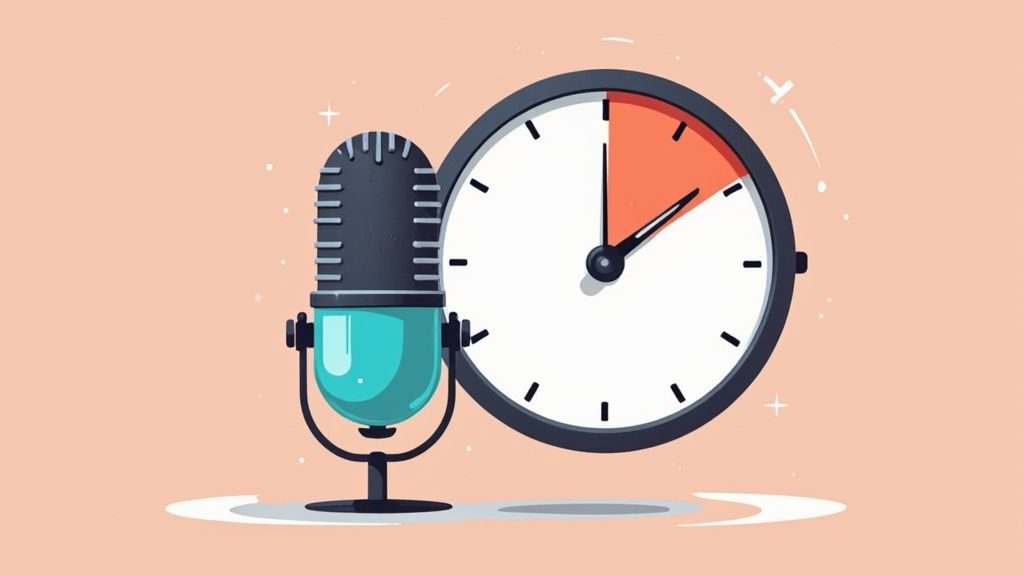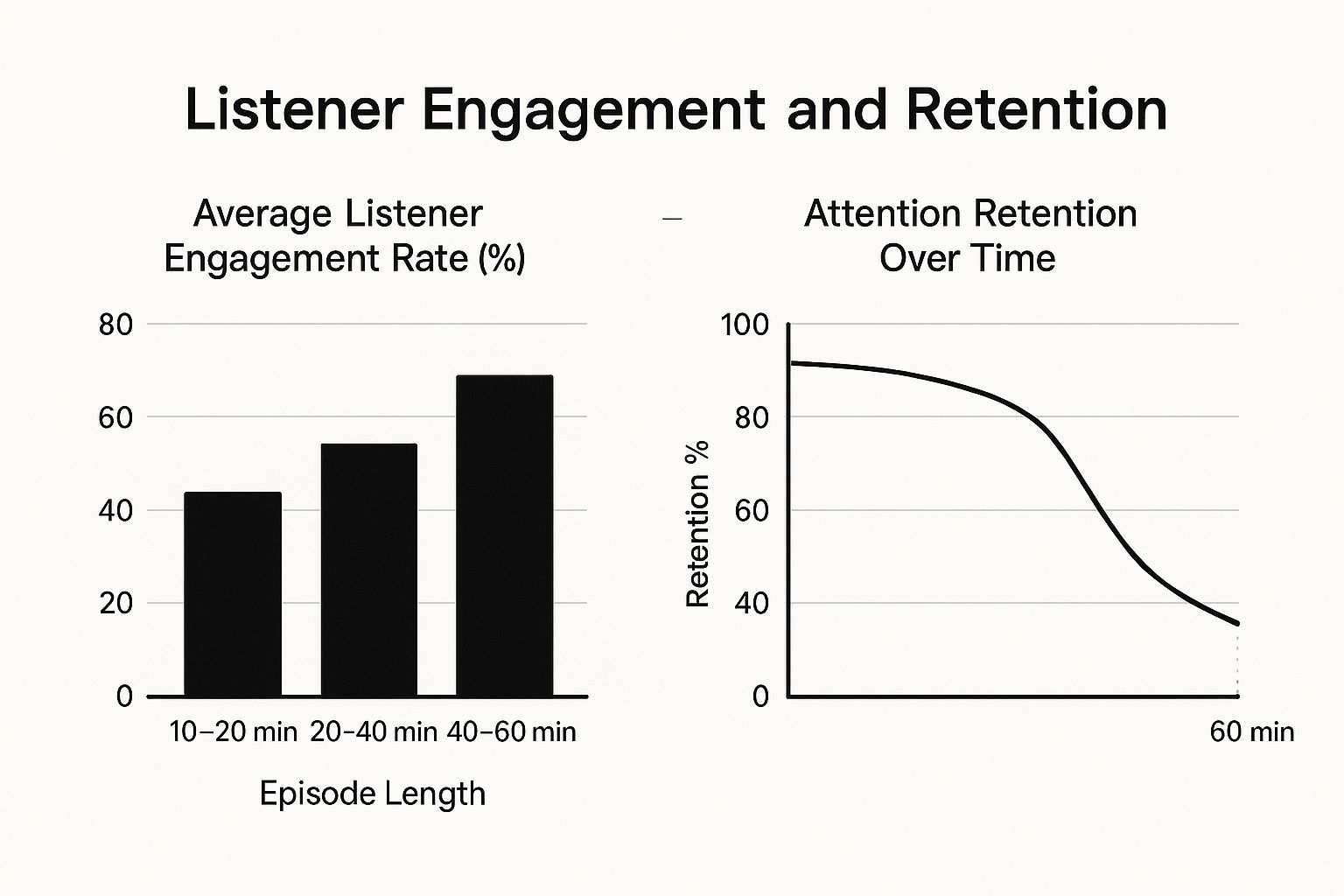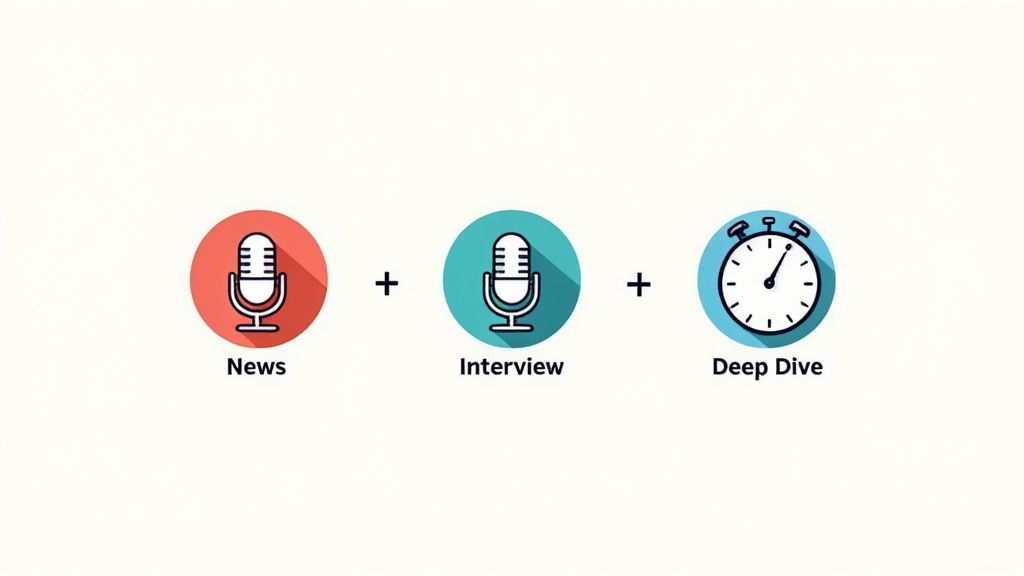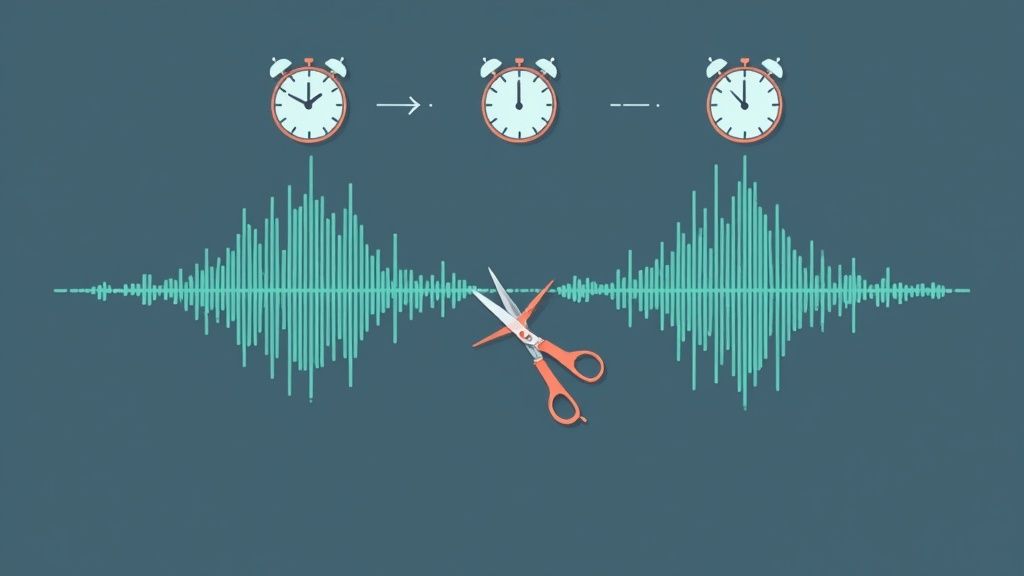So, what’s the perfect length for a podcast episode? While there’s no magic number, the data consistently points to a sweet spot: the 20 to 40-minute range.
For most shows, this is where you hit peak listener engagement. It’s long enough to deliver some real value but short enough that you’re not asking for a huge time commitment from your audience.
Finding The Sweet Spot For Podcast Episode Length

Every creator wrestles with this. You have to balance going deep on a topic with making it convenient for people to actually listen. The goal is to create something that slots perfectly into an existing daily routine—think of a commute, a gym session, or a lunch break.
This isn't just a hunch; it's what listener behavior tells us.
Looking at data from over 1,500 aspiring podcasters, that 20- to 40-minute window has been the dominant format for years. Back in 2021, 31% of all podcasts landed in this range. The following year, that number ticked up to 32%. It’s a trend that has held remarkably steady.
A quick look at the industry data shows just how popular different episode lengths are and where they tend to be used most effectively.
Podcast Episode Length Distribution at a Glance
As you can see, while shorter episodes make up the largest single category, the 20-40 minute block is a powerful contender and often the best fit for delivering substantial, engaging content without overwhelming listeners.
Why Shorter Is Often Smarter
This idea of respecting the listener's time is even more critical for B2B podcasts. Your audience is busy, and their attention is a precious commodity.
A great strategy we've seen work time and again is to record a long, free-flowing conversation—maybe 45 to 60 minutes—to get all the rich, unfiltered gold from your guest.
But the real magic happens in post-production. You take that raw recording and slice it down to a tight, polished 25 to 30-minute episode. This forces you to cut the fluff and ensure every single second is packed with value. The result? Dense, actionable content that’s perfect for a professional on a tight schedule. Ideally, it should fit into someone's lunch break or commute.
This philosophy isn't unique to podcasting. It mirrors the principle that more content doesn't always mean more engagement that we see everywhere, especially on short-form video platforms like Reels.
Using Data to Guide Your Decision
At the end of the day, your own analytics are your best friend. The most important metric to watch is Apple Average Consumption.
If you're consistently seeing over 70% average consumption, that's a huge green flag. It tells you that your content is hitting the mark and your listeners are hooked. It also suggests the content is strong and you could consider making episodes longer.
This data-driven approach takes all the guesswork out of it. You’re letting your audience’s habits guide your strategy instead of just following industry averages. Getting these details right is a huge part of building a show that sticks, and it’s a topic we cover in our full guide to https://www.fame.so/post/podcast-best-practices.
Why the 20 to 40 Minute Gold Standard Works
So, what's the magic behind that 20 to 40-minute window? Why do so many successful shows land right in this sweet spot? It’s not a random number; it’s a smart move that taps directly into listener psychology and the simple realities of our daily routines.
Think about it. This length is tailor-made for the morning commute, a good session at the gym, or knocking out some chores around the house. It lets someone hit play and finish the whole episode in one go. That feeling of completion is satisfying—a little mental checkmark that makes them eager to come back for more.
It’s like choosing between a binge-worthy 30-minute sitcom and a three-hour epic movie. Both have their place, but the sitcom is just an easier, more frequent "yes." The same logic applies to the average length of a podcast.
Respecting Listener Attention
The big enemy here is attention fatigue. We've all felt it. It’s that point where your brain just starts to wander off. If you push much past the 40-minute mark, you’re gambling with your audience's focus, risking they’ll tune out before you even get to your best stuff.
Keeping it tight forces you to be ruthless with your content. Every minute has to count, which means cutting the fluff and getting straight to the value.
The data backs this up. Take a look at how listener engagement is tied directly to how long you talk.

As you can see, the drop-off is real. Retention plummets as episodes drag on, proving just how risky it is to produce marathon-length content.
Following Established Patterns
This isn't just a theory; it's a pattern you can see across the entire podcasting world. Episode lengths have naturally settled here because that's what listeners respond to. Even platform algorithms tend to favor shows with consistent engagement.
In fact, the numbers show that nearly 32% of all podcast episodes on the planet fall neatly into this 20 to 40-minute range. It’s the unofficial industry standard for a reason.
Of course, this ideal length is also connected to the very DNA of your show. Your chosen podcast format will have a huge say in whether you can deliver knockout value in this window. An interview show slides into this timeframe perfectly, while a solo monologue might need to be even shorter and punchier to hold onto that attention.
At the end of the day, the 20-40 minute standard works because it puts the listener first. It respects their time, slots into their life, and matches how people actually listen to audio today.
How Your Podcast Genre Shapes Episode Length

That 20 to 40-minute window is a solid rule of thumb, but it’s far from the whole story. The true average length of a podcast isn't about hitting a magic number; it’s about serving a purpose. And the biggest factor influencing your episode's runtime isn't a stopwatch—it's your genre and what your audience expects from it.
Think of it this way. A five-minute daily news briefing gets its value from being fast and punchy. A deep-dive historical podcast, on the other hand, might need an hour just to set the scene. If you tried to force one into the other's time slot, you'd kill what makes it great.
Matching Duration to Content Style
Different formats just naturally ask for different amounts of a listener’s time. A solo show or a classic interview often lands perfectly in that 20 to 40-minute sweet spot. It's just enough time to dig into a topic without your audience starting to check their watches.
But then you have genres built on suspense and rich detail, like investigative journalism or true crime. These shows can hold attention for much longer. Their listeners have signed up for an immersive experience; they want all the intricate details and will happily invest 60 minutes or more to get the whole story.
For B2B podcasts, the name of the game is fitting into a professional's packed schedule. A killer strategy is to record a long, free-flowing conversation—for B2B podcasts we typically recommend recording for 45 minutes to an hour—to capture those raw, valuable insights. The real work happens in the edit, where you slice and dice that raw material into a polished 25 to 30-minute episode that's all signal, no noise.
This approach respects your listener's time while still delivering the high-level content they’re looking for. The goal is to create something they can easily knock out on a commute or during a lunch break, making your show both valuable and incredibly convenient.
A Practical Framework for Different Genres
To get your content aligned with what listeners want, it helps to see how different formats compare. The core question is always: what is my audience looking for when they hit play? Are they after a quick hit, a detailed lesson, or pure entertainment? Your answer is the best guide you'll ever have.
Here’s a simple table to help you map your episode length to your content style and audience.
Recommended Podcast Length by Genre
At the end of the day, let your content's needs call the shots. Don't stretch a 20-minute idea to fill a 40-minute slot, and don't cram a complex story into a tiny window. The best podcasters know the average length of a podcast isn’t about industry stats—it's about perfectly serving their specific audience.
A Smart B2B Podcasting Length Strategy

When your audience is full of busy professionals, the old rules for podcast length go out the window. Time isn't just a number; it's their most valuable currency. You aren't competing for their downtime—you're fighting for a tiny, precious slot in their packed workday.
This means you can't just hit record, ramble on, and publish whatever comes out. The best B2B shows are built on a specific, calculated approach: capture a ton of knowledge, then distill it into something potent and respectful of your listener's time.
The Record-Long, Edit-Short Method
Here’s a winning strategy we've seen work time and again: record a longer, in-depth conversation. We typically recommend recording for 45 minutes to an hour with your expert guests. This gives the conversation room to breathe, letting you uncover those candid insights and spontaneous bits of gold you’d totally miss in a rushed, tightly scripted format.
But the real magic happens in post-production.
The next step is to strategically edit that raw material down to a polished, high-impact episode of 25 to 30 minutes. This isn't just about chopping out content to hit a time limit; it's a curation process. You’re isolating the most powerful ideas, the most actionable advice, and the most compelling moments. Every second has to earn its place.
This process ensures your podcast is dense with expertise, totally free of fluff, and perfectly designed to fit into a professional's schedule. The goal is to create an episode that slips seamlessly into a commute or a lunch break, making your show a convenient—and indispensable—resource.
This "record-long, edit-short" model respects your listener's schedule while still delivering the deep expertise they’re looking for.
Why This Approach Wins in B2B
This disciplined editing process does more than just make for a tight episode. It transforms a good conversation into a great, repeatable listener experience that aligns perfectly with your business goals.
Here’s why this method is so effective:
- Maximizes Value: By distilling an hour of conversation into 30 minutes, you guarantee only the strongest points make the final cut. Listeners get a concentrated dose of insights without any filler.
- Fits Modern Workflows: A 25-minute episode is the perfect companion for a drive to the office, a quick workout, or a lunch break. It doesn’t demand a huge time commitment, which makes it much easier for new listeners to give your show a try.
- Builds a Loyal Audience: When busy professionals know your podcast will always deliver high-impact ideas without wasting their time, they’re far more likely to subscribe and make it a regular habit.
By adopting this focused approach, you're not just creating audio content; you're building a strategic asset. For more on turning your show into a powerful engine for growth, check out our complete guide to B2B podcasting.
Letting Your Data Define the Perfect Length
Instead of chasing a magic number or getting lost in guesswork, the best podcasters let their audience’s actual behavior call the shots. Your own analytics are a goldmine of direct, unfiltered feedback that can tell you exactly how to fine-tune your episode length.
It’s tempting to obsess over vanity metrics like total downloads, but for a moment, let's push those aside and zero in on what really matters for engagement.
The single most important metric here is your average consumption rate. You can find this inside platforms like Apple Podcasts and Spotify, and it shows you the exact percentage of an episode your average listener actually finishes. It's the most honest indicator you have for how well your content is holding people's attention.
Turning Data Into Action
Think of your consumption data as a roadmap. It shows you precisely where listener engagement is strongest and, more importantly, where it starts to drop off a cliff.
If you consistently see a steep decline around the 25-minute mark across several episodes, that's not a coincidence. It’s a powerful signal from your listeners telling you it’s time to be more ruthless with your editing.
On the other hand, if you’re seeing a consistently high completion rate, that’s a massive green flag. It tells you that your content is hitting the mark and your listeners are sticking around for the whole ride.
What we do is track Apple Average Consumption and if we're consistently seeing over 70% average consumption, then that suggests the content is strong and we could consider making episodes longer.
This data-driven approach takes all the guesswork out of finding the right average length of a podcast for your show. You’re no longer just following some generic industry trend; you’re responding directly to the proven habits of your own audience.
The Feedback Loop for Continuous Improvement
This isn't just a one-and-done check-in. It’s an ongoing feedback loop that helps you continuously refine and improve your show over time. By regularly checking your analytics, you can make informed decisions that build listener loyalty and keep your audience growing.
Focusing on listener behavior is absolutely fundamental to creating a show that lasts. If you want to go deeper on the key performance indicators you should be tracking, check out our detailed guide on how to measure podcast performance. It'll help you build a complete picture of what’s working and where you have opportunities to get even better.
Averages, Outliers, and the Bigger Picture
You might see reports that the global average podcast length is a bit higher than that 20-to-40-minute sweet spot we keep talking about. And you'd be right. But that's not a contradiction—it’s just how math works.
The global average length of a podcast gets pulled way up by a bunch of really popular, long-form shows. Think about those deep-dive narrative series or sprawling interviews; they need more runway to tell a compelling story, and that skews the data for everyone else. Industry numbers put the average episode at 43 minutes, which shows just how many podcasts are pushing well past that 40-minute mark. You can dig into more B2B podcasting trends and data to see these patterns for yourself.
Thriving on the Fringes
Just as the long shows pull the average up, there are plenty of hit podcasts on the shorter end of the spectrum. In fact, about 16% of podcasts are under 10 minutes long. They thrive on being quick and to the point, perfect for delivering daily news hits or a single powerful insight.
And on the other extreme? A full 18% of podcasts run for over an hour. These aren't just rambling conversations; they're outliers that succeed because they serve a specific niche audience—people who are absolutely hungry for in-depth content and are more than happy to commit the time.
Here's the key takeaway: While that 20 to 40-minute window is a safe and effective bet for most B2B shows, you can find success anywhere on the spectrum. It's not about chasing a global average. It’s about matching your episode length to your show's format and, most importantly, your audience's expectations.
At the end of the day, there’s no single "correct" length. The best duration is the one that lets you deliver maximum value without overstaying your welcome.
Common Questions About Podcast Length
Look, even with all the data in the world, you're still going to run into specific situations that make you second-guess your episode length. That's totally normal.
Let's walk through a few of the most common questions I hear from podcasters, so you can handle them with confidence.
Should I Split a Long Interview into Two Parts?
Great question. If you’ve got a recording that's pushing past the 60-minute mark, my default advice is yes, absolutely split it. It’s a smart play. You instantly double your content output and give your audience two much more manageable episodes. This makes it way more likely they’ll actually finish both.
The only exception? If the conversation is a single, gripping story that builds on itself. If breaking it apart would ruin the narrative tension, then you keep it as one epic episode. Otherwise, two is better than one.
Does Video Podcast Length Differ from Audio?
It often does, and for a good reason. People on platforms like YouTube are just wired differently; they're more conditioned to settle in for longer-form content, especially for deep-dive interviews where visuals add to the experience.
So yes, you can get away with longer runtimes on video. But—and this is a big but—you have to become obsessed with your audience retention graph in YouTube Studio. If you see a major drop-off at a certain point, that's your audience telling you exactly where you lost them. That's your signal to either tighten up the edit or drop in some more engaging B-roll or graphics to keep their eyes on the screen.
A quick side note: for anyone serious about repurposing content or making their show more accessible, getting the fastest AI audio transcription is a game-changer. Transcripts make your episodes searchable and open them up to a whole new audience, no matter how long they are.
Should I Tell Listeners the Episode Length Upfront?
Honestly, don't waste your breath. Anyone listening on a podcast app can already see the runtime before they hit play. It's right there on the screen.
Instead of announcing the length, pour all that energy into crafting a killer hook for your intro. A genuinely compelling preview of the value you’re about to deliver will do infinitely more to convince someone to stick around than telling them it’s a "27-minute episode." Hook them with the what, not the how long.
At Fame, we're in the business of turning B2B conversations into assets. We don’t just hit record; we build shows with concise, high-impact episodes that respect your audience's time and drive real business outcomes. Learn how we can build your authority through podcasting.

